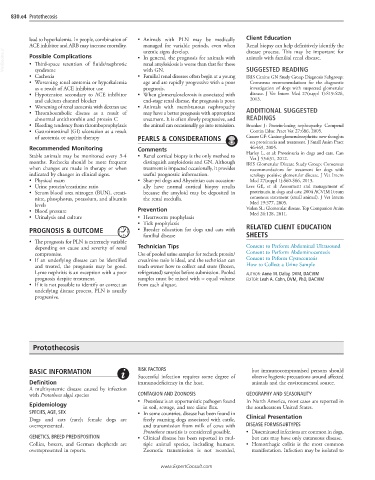Page 1651 - Cote clinical veterinary advisor dogs and cats 4th
P. 1651
830.e4 Protothecosis
lead to hyperkalemia. In people, combination of • Animals with PLN may be medically Client Education
ACE inhibitor and ARB may increase mortality. managed for variable periods, even when Renal biopsy can help definitively identify the
VetBooks.ir Possible Complications • In general, the prognosis for animals with animals with familial renal disease.
uremic signs develop.
disease process. This may be important for
renal amyloidosis is worse than that for those
• Third-space retention of fluids/nephrotic
syndrome
with GN.
• Cachexia • Familial renal diseases often begin at a young SUGGESTED READING
IRIS Canine GN Study Group Diagnosis Subgroup:
• Worsening renal azotemia or hyperkalemia age and are rapidly progressive with a poor Consensus recommendations for the diagnostic
as a result of ACE inhibitor use prognosis. investigation of dogs with suspected glomerular
• Hypotension secondary to ACE inhibitor • When glomerulosclerosis is associated with disease. J Vet Intern Med 27(suppl 1):S19-S26,
and calcium channel blocker end-stage renal disease, the prognosis is poor. 2013.
• Worsening of renal azotemia with dextran use • Animals with membranous nephropathy
• Thromboembolic disease as a result of may have a better prognosis with appropriate ADDITIONAL SUGGESTED
abnormal antithrombin and protein C treatment. It is often slowly progressive, and READINGS
• Bleeding tendency from thromboprophylaxis the animal can occasionally go into remission. Brunker J: Protein-losing nephropathy. Compend
• Gastrointestinal (GI) ulceration as a result Contin Educ Pract Vet 27:686, 2005.
of azotemia or aspirin therapy PEARLS & CONSIDERATIONS Grauer GF: Canine glomerulonephritis: new thoughts
on proteinuria and treatment. J Small Anim Pract
Recommended Monitoring Comments 46:469, 2005.
Stable animals may be monitored every 3-4 • Renal cortical biopsy is the only method to Harley L, et al: Proteinuria in dogs and cats. Can
Vet J 53:631, 2012.
months. Rechecks should be more frequent distinguish amyloidosis and GN. Although IRIS Glomerular Disease Study Group: Consensus
when changes are made in therapy or when treatment is impacted occasionally, it provides recommendations for treatment for dogs with
indicated by changes in clinical signs. useful prognostic information. serology positive glomerular disease. J Vet Intern
• Physical exam • Shar-pei dogs and Abyssinian cats occasion- Med 27(suppl 1):S60-S66, 2013.
• Urine protein/creatinine ratio ally have normal cortical biopsy results Lees GE, et al: Assessment and management of
• Serum blood urea nitrogen (BUN), creati- because the amyloid may be deposited in proteinuria in dogs and cats: 2004 ACVIM Forum
nine, phosphorus, potassium, and albumin the renal medulla. consensus statement (small animal). J Vet Intern
levels Med 19:377, 2005.
• Blood pressure Prevention Vaden SL: Glomerular disease. Top Companion Anim
Med 26:128, 2011.
• Urinalysis and culture • Heartworm prophylaxis
• Tick prophylaxis
PROGNOSIS & OUTCOME • Breeder education for dogs and cats with RELATED CLIENT EDUCATION
familial disease SHEETS
• The prognosis for PLN is extremely variable
depending on cause and severity of renal Technician Tips Consent to Perform Abdominal Ultrasound
compromise. Use of pooled urine samples for recheck protein/ Consent to Perform Abdominocentesis
• If an underlying disease can be identified creatinine ratio is ideal, and the technician can Consent to Peform Cystocentesis
and treated, the prognosis may be good. teach owner how to collect and store (frozen, How to Collect a Urine Sample
Lyme nephritis is an exception with a poor refrigerated) samples before submission. Pooled AUTHOR: Anne M. Dalby, DVM, DACVIM
prognosis despite treatment. samples must be mixed with ≈ equal volume EDITOR: Leah A. Cohn, DVM, PhD, DACVIM
• If it is not possible to identify or correct an from each aliquot.
underlying disease process, PLN is usually
progressive.
Protothecosis
BASIC INFORMATION RISK FACTORS but immunocompromised persons should
Successful infection requires some degree of observe hygienic precautions around affected
Definition immunodeficiency in the host. animals and the environmental source.
A multisystemic disease caused by infection
with Prototheca algal species CONTAGION AND ZOONOSIS GEOGRAPHY AND SEASONALITY
• Prototheca is an opportunistic pathogen found In North America, most cases are reported in
Epidemiology in soil, sewage, and tree slime flux. the southeastern United States.
SPECIES, AGE, SEX • In some countries, disease has been found in
Dogs and cats (rare); female dogs are freely roaming dogs associated with cattle, Clinical Presentation
overrepresented. and transmission from milk of cows with DISEASE FORMS/SUBTYPES
Prototheca mastitis is considered possible. • Disseminated infections are common in dogs,
GENETICS, BREED PREDISPOSITION • Clinical disease has been reported in mul- but cats may have only cutaneous disease.
Collies, boxers, and German shepherds are tiple animal species, including humans. • Hemorrhagic colitis is the most common
overrepresented in reports. Zoonotic transmission is not recorded, manifestation. Infection may be isolated to
www.ExpertConsult.com

